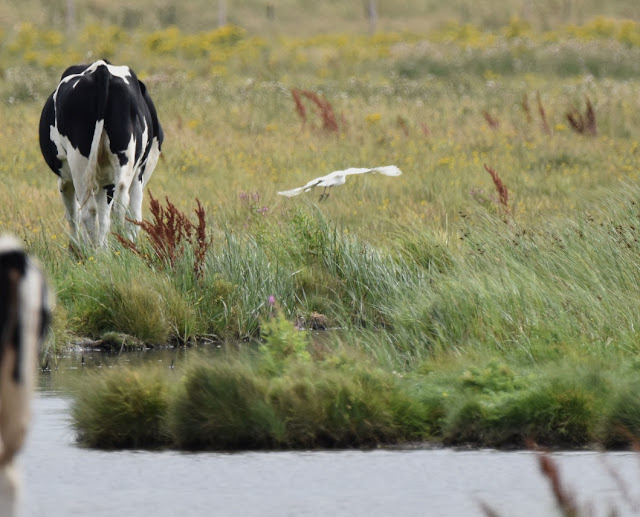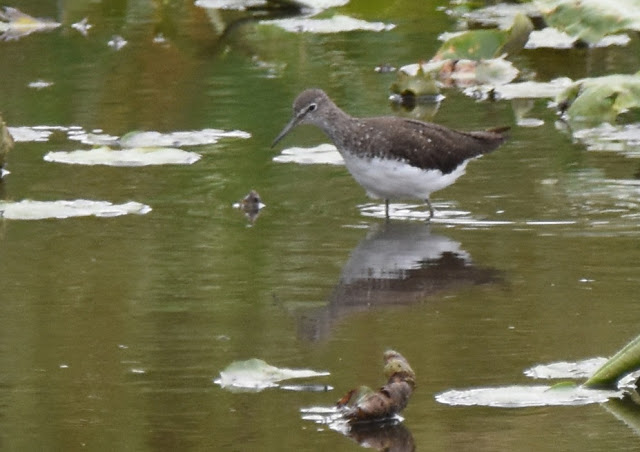The Safari was invited to go to Blackburn this morning to do a short interview about this blog and wildlife in general (very general as it turned out - we didn't get enough air-time to go in to much detail) on the local radio station. Once we'd finished the interview and made arrangements for a live outside broadcast wildlife show later in the autumn we headed back to the coast. Not our coast but the Southside's coast. Almost there we got side tracked by the reserve 'we do not mention by name'. It was pretty good although the sunny weather inland had deteriorated to dull and cold - we'd considered not wearing our jacket but were really glad we'd ignored ourself.
It's the middle of August and the middle of the day, you really shouldn't need flash to photograph Giant Puffballs even if they are growing under the trees.
At the furthest hide there wasn't a great lot of birds to be seen and those that were about were very distant. We had hoped to find our first Little Ringed Plover of the year but none were showing.
We did pick up a fly-past Green Sandpiper and a little later a female type Marsh Harrier. A couple of Snipe flew round briefly but we were surprised to learn from the regular birders that they don't breed here despite the vast acreage of wet grassland of varying lengths and tussockiness being available. Never seen so many Stock Doves here before either, there must have been nearly 50 in the flock feeding on the seeds dropped from the recently cut grass.
Walking back we stopped at all the hides we'd passed on the way out. The first one gave us a different couple of Snipe.
And the same or another Green Sandpiper, apparently there had been two here a little earlier but we could only find this one after a fair bit of searching.
Again everything was just a little bit too distant for proper pics; apart from this female Blackcap, which was nearer but a lot smaller so still a bit tricky for a proper pic.
At the next hide we were infuriated by an adult Little Grebe that just wouldn't show itself properly choosing to remain mostly hidden behind the bankside vegetation or underwater. But there was a bit of compensation when a third Green Sandpiper flew through. Normally we only get one or two of these a year and sometimes just a 'heard only' night-time fly-over so three in a day and so far four in the year is pretty good going.
The feeding station was very busy with the usual garden birds.
At the last two hides we couldn't find our Little Ringed Plover, are we going to end up with an embarrassing gap on our Year List Challenge with Monika? According to the Reserve's sightings log there were two out there...grrr!
We did see the Marsh Harrier again and watched a good fly past by a large flock of Grey Lag Geese that took flight as the harrier drifted near them.
The poor weather meant we didn't see any inverts of note apart from thbis rather splendid White Tailed Bumble Bee outside one of the hides.
With all hides visited and all possibilities exhausted we left for the coast.
 |
| Phone cam |
This short stretch of the coast is getting very like the Mediterranean, only a couple of weeks ago we were watching the Glossy Ibis and this time we had to dodge a multitude of Little Egrets to spot the Cattle Egret (167)...wasn't that difficult, just look for the cows and there it was...but distant...we'd spent too long at the previous reserve and missed it right in front of the hide by about half an hour. It did the typical Cattle Egret thing walking among and alongside the cattle as the wandered across the reserve. Even though it's white like a Little Egret it's a different shade of white if that makes sense.
 |
| Deffo a Cattle Egret - note the lack of yellow feet |
 |
| Dreadful pics of only the second British one we've seen |
Once the cattle had settled down the egret disappeared into the long grass and out of sight. That was our cue to have a look at what else was on offer on the reserve. A good flock of about 350 Black Tailed Godwits almost out of sight in the far pool might well have held the Curlew Sandpiper that flew past the hide heading that way not long before we arrived. They were spooked by something and got up but we never picked up on the much smaller bird, however we did hear but didn't see a Greenshank calling.
Today wasn't the day to be a 3-Spined Stickleback - we'd guess that here no day is a particularly good day to be one! Two juvenile Little Grebes have become very proficient at catching themselves lunch rather than have it provided by ma n da. We watched this one catch half a dozen in almost as many minutes and with a success rate of not quite one every dive.
Many more losses were inflicted by three Little Egrets. Their sideways looking stalk is very effective even if it does look a little ungainly at times. At one point the three egrets came together and invaded each other's space whereupon a bit of a hoo-har broke out between them with the most dominant chasing the other two away and ending up with the pool to itself.
The pool to the right was quiet the only excitement being the family of Avocets asleep on the island in the furthest corner. A noisy family of Black Headed Gulls landed briefly, well the adults were quiet but their youngster was begging very noisily until it was fed with something regurgitated after which they flew off again leaving the Avocets to their slumbers. With the Avocets, Little Egrets, Cattle Egret and recent Glossy Ibis only the local Great White Egret(s?) were missing to make this little patch of Lancashire more like the Carmargue than Lancashire of 20 odd years ago...now if there'd been some white horses and black cattle...
 |
| Going |
 |
| Gone |
 |
| Gotcha |
All the best action was looking the other way where about 50 - 60 Swallows were resting on the reserve's boundary fence. All manner of preening and stretching was going on as they conserved energy and worked their feathers into tip top condition ready for their massive journey to South Africa. Above the hide windows is a small colony of House Martins and although they spent some time on the fence they were just as likely to be seen still collecting balls of mud on the nearby little island.
Also visiting the island were the odd camera-shy Meadow Pipit and far less shy Goldfinches, which judging by the proportion of juveniles have had a productive breeding season round these parts.
Also visiting the island were the odd camera-shy Meadow Pipit and far less shy Goldfinches, which judging by the proportion of juveniles have had a productive breeding season round these parts.
Every now and then the Swallows would flush and take to the air but would soon settle down to start their preening and stretching routine again.
One sharp eyed observer spotted a Sand Martin flying around with the throng of Swallows and House Martins and fortunately it joined the Swallows on the fence not too far away.
One sharp eyed observer spotted a Sand Martin flying around with the throng of Swallows and House Martins and fortunately it joined the Swallows on the fence not too far away.
On Tuesday we had a surprise when we arrived at work. We opened the car door and got our bag from the back and heard a Common Sandpiper (P2 #69) calling very loudly. We looked round but didn't see it, ah well we thought, that's a good fly over record they're not annual on Patch 2. Leaving the car and walking to the front door we heard it again even louder this time, turning to where the sound had come from we saw it flying up over the front hedge, it had been on the lawn! Later we learned that there'd been two earlier in the morning at the nature reserve so it looks like there was a bit of over night movement.
News also reached us of a seal that had been seen on the beach on Saturday. Photos were brought into work showing it to be a juvenile Harbour Seal, a very infrequent visitor to our coast and probably ill or starving and dehydrated (they get their fresh water from their food). By strange coincidence minutes after we were given the photos from the weekend it appeared on a colleague's Facebook feed from that morning not far from work. We sent news of it to the local British Divers Marine Life Rescue rep TH but the tide was coming in and she'd have to wait until late afternoon to go out to look for it.
We didn't hear back from her so can only assume she didn't find it.
 |
| phone pic of a photo on glossy paper |
Where to next? Back to Patch 2 tomorrow if wind and rain permit.
In the meantime let us know how Mediterranean it is in your outback.


















1 comment:
A cracking selection there Dave. I was at Marshside the following day, there were nothing like that number of Swallows on the fence, with maybe just half a dozen max settling on the fence wires. The Little Grebes happily feeding right in front of the hide were a delight, & I've not seen that many Little Egrets there before - great to watch them feeding. I was feeling a bit sorry for the Cattle Egret, looked fed up hunkered down getting out of the wind & rain & the Little Egrets kept having a go at it too.
Post a Comment